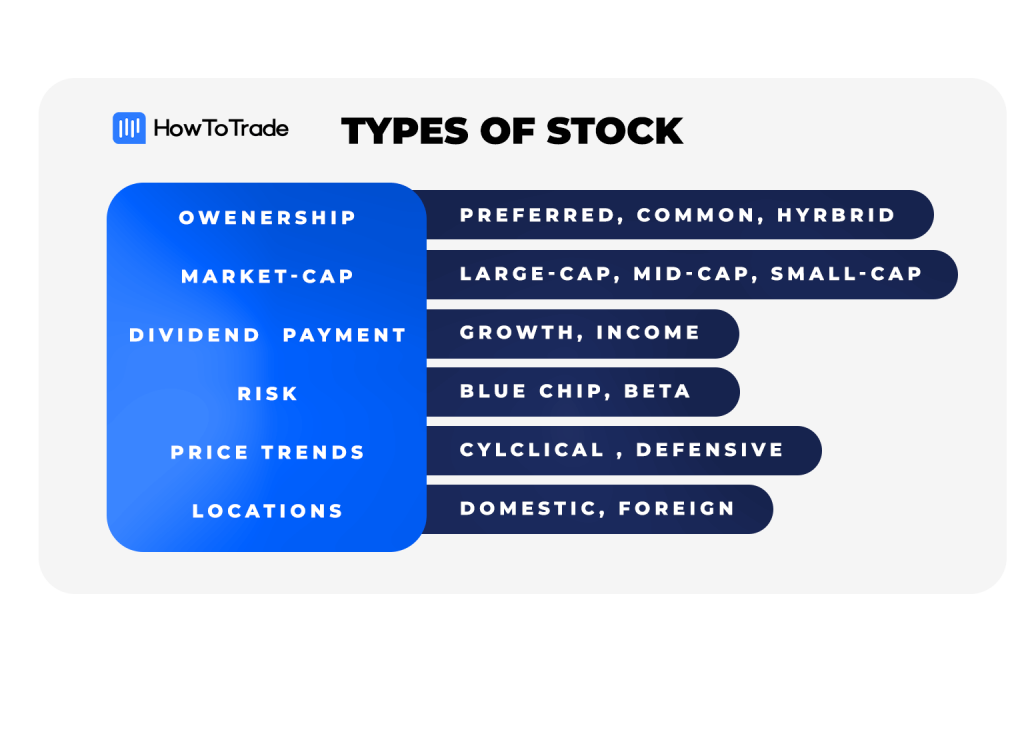Types of Stocks Every Investor Should Know
One of the most important things when it comes to trading stocks is learning how to pick the right ones to trade. However, before we dig deeper into how to find the right stocks, it’s important we show you that stocks come in many different shapes and forms.
And different types of stocks come with different privileges, different levels of risk, and different profit potentials. If you can determine which kind of stocks best suits your financial situation, skills, and goals, you can find your niche in the multi-faceted world of stock trading and focus your efforts in the right direction. And for that reason, we must introduce you to different types so you can decide what fits you best. Let’s start then.
What Are The Different Types of Stocks?
Stocks can be divided into multiple categories using a number of different parameters such as the company size, ownership type, market capitalization, dividend payments, industry, risks, and country.
Below, we will cover each one of these categories to guide you to a better understanding of the different types of stocks.

Stocks By Ownership
The basis of ownership rules is the most common parameter for classifying stocks. This means that the given company will decide whether to offer common, preferred, or hybrid stocks.
Common Stocks
If you are new to investing in stocks and only looking to buy a few shares here and there, you are very likely to invest in common stocks, which are exactly what its name suggests – The most common type of stock.
When an investor purchases common stock, they are typically also granted voting rights (typically one for each share) and a stake in the organization’s profits. Generally, the more shares an investor owns, the stronger the vote.
Preferred Stocks
Preferred stocks, also often compared to bonds, are the other primary type of stock. And as the name suggests (again), preferred shareholders get preferred treatment. This means that when an investor holds a preferred stock, fixed dividends are paid to them, and in the case of liquidation or bankruptcy, preferred stockholders will get their shares before common shareholders do. They are usually bought by investors who prioritize income over long-term growth.
Hybrid Stocks
Hybrid stocks, also called convertible preferred shares, come with an option to be converted into a predetermined number of common stocks at a specified time. Hybrid stocks, however, usually do not come with voting rights like common stocks.
Different Market-Caps
Another way to categorize stocks is by the company’s size, shown in its market capitalization or market cap. They vary from mega-cap all the way to micro-cap stocks.
The market capitalization, or market cap, can be calculated by multiplying the price of a stock by the overall number of outstanding shares. Generally, more prominent companies that are more established have greater global exposure, and therefore a significant percentage of the large-cap organization’s profits come from investors from around the world.
Meanwhile, smaller-cap stocks and mid-cap companies tend to be less established, less well-known, and therefore more domestically oriented. Therefore, investing in these companies can be risky, but it also offers more growth potential as the stock price can reflect the company’s exponential growth.
Cap Size Matters
Below, you can find a breakdown that gives some rough parameters on the ‘cap’ sizes.
- Micro-Cap stocks: $50 -$300 million (also known as penny stocks)
- Small-Cap stocks: $300 million – $2 billion
- Mid-Cap stocks: $2 billion – $10 billion
- Large-Cap stocks: $10 billion-plus
- Mega-Cap stocks: $200 billion-plus
Stock Style Categories
Stocks can also be categorized by the style of investing. These categories usually differ in how stocks are valued and companies make their money.
Value Stocks
Value stocks are shares that are being sold for a price lower than their actual worth. Investors believe that by buying companies that are priced low, they can profit as the gap narrows over time.
Growth Stocks
Growth stocks are shares in organizations that are growing at a fast pace and/or are expected to continue their growth at a faster rate than their competitors.
Cyclical Stocks
Cyclical stocks are shares in a company that typically moves in the same direction of economic growth. When the economy is boosting, cyclical stock prices usually provide higher long-term returns. And when the economy is in recession, these stocks fall sharper than other types of stocks like defensive stocks or blue chip stocks.
Income Stocks
Income stocks, also known as dividend stocks, offer a steady income, typically in the form of profit distribution. Income stock companies pay dividends once or twice a year, offering investors a fixed income annual return.
Stocks By Sector
Stocks are often grouped by the industry that that organization falls within. There are eleven recognized sectors, and these include:
- Energy
- Utilities
- Real Estate
- Communication Services
- Health Care
- Financials
- Information Technology
- Consumer Discretionary
- Consumer Staples
- Industrials
- Materials
For more information, please click here.
Stocks By Country
Stocks can be classified by the country or region in which their headquarters are, even if the company operates globally. Investors looking to buy shares in International stocks can do so with ETFs, which hold numerous foreign companies within a single share.
EAFE
EAFE, which stands for Europe, Australasia, and the Far East, is a common index used for international stock funds. These countries are all developed, which means they have established financial markets and mature economies.
Emerging-Market Stocks
Emerging-market stocks refer to the companies whose headquarters are in countries whose economies are described as developing. These include countries such as India, Mexico, Brazil, and the Philippines.
Investing in emerging markets is believed to be riskier, but it also provides an opportunity for high rates of growth.
Stocks By Risk
Stocks are often grouped by the industry that that organization falls within. There are eleven recognized sectors, and these include:
Blue-Chip Stocks
The blue-chip stocks are the shares of well-established companies with stable profits. Investing in these companies is often considered to be a safe option. They are named after blue-colored chips in the game of poker, as they are considered the most valuable.
Beta Stocks
Beta stocks are shares in ‘risky’ companies. However, investors believe that the riskier the share is, the more the price fluctuates and, therefore, the greater the potential to make profits.
The Bottom Line
And now that you know the different types of stocks, you can use your knowledge as you plan for your future investments. Investing in organizations of varying market cap, locations, and investing styles contributes to a well-balanced portfolio and improves your chances for success.
But remember, at the end of the day, investing in stocks isn’t necessarily about its category but whether you believe in the company’s long-term growth potential.

